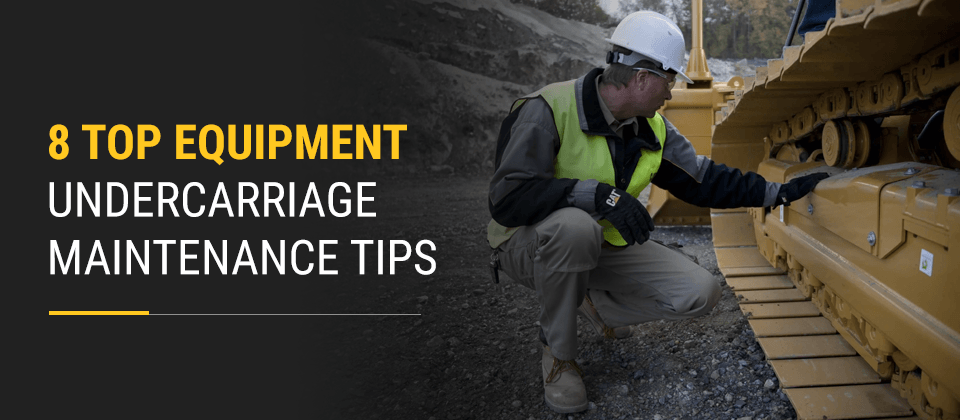

The undercarriage of heavy equipment is incredibly important. With so many moving parts, regular upkeep is essential for the best performance and life span of your equipment. You can often find some of the first signs of wear and tear on the underside of heavy machines.
Giving your equipment the attention it deserves can prevent unnecessary downtime and save you a lot of money. Learn more about how to maintain your equipment’s undercarriage and the benefits of doing so.
When operating machinery, especially outside, it is your responsibility as the operator to maintain each piece so that it functions correctly for as long as possible. The following are benefits of undercarriage maintenance:
There are so many benefits to taking great care of your machinery. If you want to better maintain the undercarriage on your equipment to elongate its life and keep it running effectively, consider implementing the following eight tips:
At the end of every workday, having operators clean the undercarriage of their equipment can be a great way of avoiding unnecessary downtime and issues. It is important to get rid of dirt and debris that can accelerate premature wear.
Operators can use pressure washers and shovels to loosen mud that can weigh the machine down, reducing fuel economy. If you work in colder climates, debris can freeze and cause the following problems:
Manufacturers have started designing newer pieces of equipment with easy-to-clean undercarriage to make this step even easier for operators.
In addition to daily cleanings, it can be very beneficial to inspect the undercarriage of equipment regularly. Completing a full inspection helps to spot excessive or uneven wear that can quickly become costly problems without attention. When checking out the undercarriage, you will want to look for damaged and missing components and whether or not the tracks are out of place. Give close attention to fluid leaks as this could indicate greater issues like a failed seal or roller.
The following are parts you should address on a routine basis:
Referencing the manufacturer’s manual for your machine can also be very helpful. You can find maintenance instructions specifically for your equipment for the best servicing possible.
One of the best tips for maintaining your equipment’s undercarriage is to stick with the basics. After training, it can be easy to forget about the best procedures that help keep a machine running optimally.
If you want to keep your equipment functioning well, refer back to these basic suggestions:
It is sometimes necessary to revisit user manuals and safety guidelines as a refresher on choosing the best practices for maintaining machinery.
When you keep the undercarriage well-oiled, each part can move smoother. Locate the grease points on your specific equipment and make sure to lubricate them at least according to the manufacturer’s specifications. Depending on the environment and situation you use your machinery in, though, you may need to grease the undercarriage once a day, or even several times a day. Greased equipment pushes dirt out and leaves little room for debris build-up.
Consider applying lubricant after the workday instead of before. Grease fittings receive oil and lubrication better when parts are warmed up. Doing this at the beginning of the workday can be less effective because components are cold.
Maintaining proper track tension is important for avoiding unnecessary wear and tear. If the tracks are too loose, you could experience heightened wear or cause slippage. When the tracks are too tight, the tension can blow out bushings.

Track tension should be set to factory specifications and adjusted for every work environment. Operators should pay attention to the environment they are working in, as soft or muddy conditions work best with looser tracks.
Every user should know the best practices regardless of how often they operate the equipment. Everyone who works with machinery should know the basics and how to perform regular maintenance. Be sure everyone has easy access to manuals for a quick refresher when needed.
Properly training operators means better driving and cleaning techniques for better performance.
With proper training, operators will understand how to drive their equipment in a way that benefits the equipment’s undercarriage. If you want to take the best care of your machinery, avoid the following:
By driving to minimize wear and tear, your undercarriage endures less damage.
One of the greatest things you can do to save money on your equipment is swapping out worn or broken parts as soon as you spot them. This helps keep the machinery running properly and prevents further damage.
Don’t put off getting replacement parts. The longer you wait, the greater the chance of other issues arising in the meantime — and new parts are much cheaper than replacing your machine entirely.
If you are looking for undercarriage service options for your heavy equipment, Wheeler Machinery Co. can help. We provide a range of services from repairing to rebuilding.
Our extensive equipment undercarriage maintenance and repair services offer the following advantages:
Conveniently schedule your service online or stop by a Wheeler location to learn more about our undercarriage solutions.
With this guide to undercarriage maintenance, you can take better care of your equipment to help keep them functioning efficiently and for longer. Our locations can support all kinds of services, from resurfacing idlers to tightening loose gears. Our team of professionals can help with your maintenance and repair needs.
Do you have questions or concerns regarding your heavy equipment’s undercarriage maintenance? Contact Wheeler Machinery Co. today!